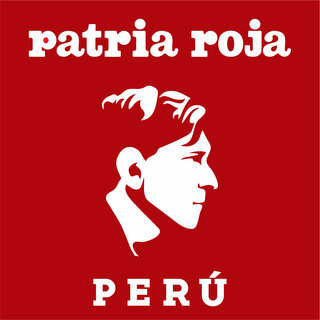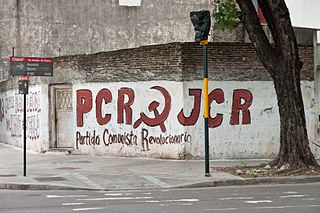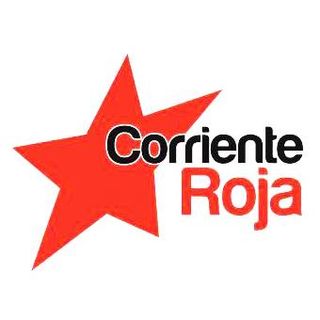
The Communist Party of Spain is a communist party that, since 1986, has been part of the United Left coalition, which is currently part of Sumar. Two of its politicians are Spanish government ministers: Yolanda Díaz and Sira Rego.

São Paulo Forum (FSP), also known as the Foro de São Paulo, is a conference of left-wing political parties and organizations from the Americas, primarily Latin America and the Caribbean. It was launched by the Workers' Party of Brazil in 1990 in the city of São Paulo.
Revolutionary Communist Party – Red Trench was a communist party in Peru. PCR-TR was formed in 1977, through a split in the PCR. PCR-TR was led by Agustín Haya de la Torre and Jorge Nieto.

The Revolutionary Left Movement was a Marxist–Leninist group founded in Peru in 1962 by Luis de la Puente Uceda and his group APRA Rebelde, a splinter group from the APRA which had rallied the government in the 1950s and 1960s. Inspired by the Cuban Revolution and close to a non-aligned position which opposed itself to the Communist Party of Peru, the Soviet Union and China, the group initiated guerrilla actions against the government in 1965. After its leader's death at the end of 1965, the MIR split into three different factions. One of them, the MIR-EM, merged with the Revolutionary Socialist Party (Marxist-Leninist) in 1982 to create the Movimiento Revolucionario Túpac Amaru (MRTA). The two others factions, MIR-VR and MIR-IV, joined the parliamentary left-wing coalition Izquierda Unida in the early 1980s.

The Communist Party of Peru – Red Fatherland is a far-left, communist political party in Peru. It was founded in 1970, through a split in the Peruvian Communist Party – Red Flag. It is led by Alberto Moreno and Rolando Breña. Its youth wing is the Communist Youth of Peru.
Popular Democratic Unity, was a political front in Peru founded in 1977 by Revolutionary Vanguard, Revolutionary Communist Party and Revolutionary Left Movement. UDP contested the 1978 and 1980 elections. In the 1980 and 1983 municipal elections, UDP took part in IU lists.
Mariateguist Unified Party was a political party in Peru founded in 1984 by Revolutionary Vanguard (VR), Revolutionary Left Movement (MIR), Workers Revolutionary Party (PRT) and a sector of Revolutionary Communist Party (PCR). Leaders included Javier Diez Canseco, Agustín Haya de la Torre, Santiago Pedráglio, Hugo Blanco, Eduardo Cáceres and Carlos Tapia. Maria Elena Moyano was also a member of PUM.
Left Socialist Accord, was a political alliance in Peru founded in 1989 by three groups that left IU: Revolutionary Socialist Party (PSR), Revolutionary Communist Party (PCR) and Peruvian Socialist Movement (MSP). ASI contested the 1989 municipal elections. Later ASI was dissolved.
Democratic Left Movement, was a political alliance in Peru founded in 1992 by a group of small parties, the Socialist Political Action (APS), Movement of Socialist Affirmation (MAS), Revolutionary Mariateguist Party (PMR) and Revolutionary Communist Party (PCR).
The Revolutionary Left Movement – New Majority was a social democratic political party in Bolivia whose registration was annulled in 2006 after it failed achieve the electoral results needed to maintain its official registration. In the elections of 2009, the party did not field any candidates. It was a member of the Socialist International.
The Democratic and Popular Unity Party (1977–84) was a Bolivian umbrella political alliance uniting various smaller left-wing parties. It was formed in 1977 by former president Hernán Siles Zuazo and consisted chiefly of Siles' Movimiento Nationalista Revolutionario de Izquierda, a spin-off of the Moviminento Nacionalista Revolucionario, and Jaime Paz Zamora's Movimiento de Izquierda Revolucionaria. The coalition became extremely popular with Bolivian voters in the late 1970s, due to fatigue with the military dictatorships that for the most controlled the country since 1964.

The Revolutionary Communist Party is a Marxist–Leninist–Maoist political party in Argentina.
Ricardo Letts Colmenares was a Peruvian politician, journalist and left-wing militant.
The Left-wing Revolutionary Nationalist Movement was a centre-left political party in Bolivia.

United Left is a federative political movement in Spain that was first organized as a coalition in 1986, bringing together several left-wing political organizations, grouped primarily around the Communist Party of Spain.

Corriente Roja is a Spanish Trotskyist political organization, adhering to the International Workers League – Fourth International in 2012. CR defends and supports social struggles, class independence and political gains of the working class in order to establish a republic of workers. CR proposes the construction of a socialist economy, based on workers' democracy and the traditions of the alternative labor movement. According to its mission statement, current Red describes itself as follows:
Corriente Roja will put in place a strategy defined by its anticapitalist Marxist character, radically democratic, internationalist, ecologist and feminist
Anticapitalistas, known as Izquierda Anticapitalista until January 2015 and as Espacio Alternativo from 1995 to November 2008, is a socialist political organisation that works as a confederation in Spain. Anticapitalistas is defined as a revolutionary socialism, anti-capitalist, proletarian internationalist, republican, and eco-socialist organisation, assuming Marxism in an open, plural, and critical sense. Its stated objective is the rebuilding of the revolutionary project through the creation of a unitary, anti-capitalist political expression sustained by the anti-globalisation movement, the labor movement, and the social movements at large. It is a member of the Fourth International (post-reunification), a Trotskyist international organisation reformed in 1963.

Broad Left Front is a political coalition of leftist parties and movements in Peru.

The Libertarian Left is a Chilean political and social movement formed in 2015 from the merger of the Libertarian Communist Organization (OCL), the Libertarian Students Front (FEL), the Ernesto Miranda Fighting Muralist Units (UMLEM) and other groups.








